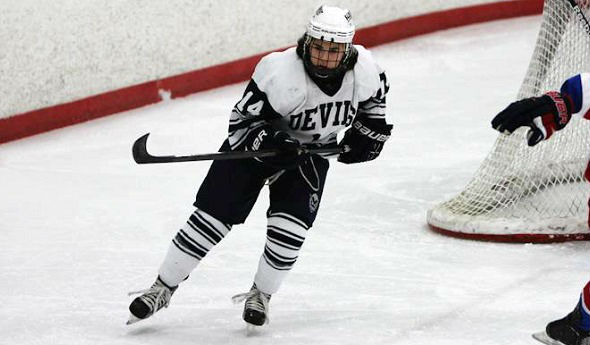
Roque Shines as Sault Ste Marie Surges
January 14, 2016
By Dennis Grall
Special for Second Half
SAULT STE. MARIE – Abby Roque has taken a somewhat unusual route to reach another high level of hockey.
 The Sault Ste. Marie High School senior, an accomplished international player on the women's side, is the only female playing on her school's boys hockey team, as she’s been each of her four seasons with the Blue Devils. She is the only girl to have ever played for the Sault, which is home to one of the top boys programs in the state.
The Sault Ste. Marie High School senior, an accomplished international player on the women's side, is the only female playing on her school's boys hockey team, as she’s been each of her four seasons with the Blue Devils. She is the only girl to have ever played for the Sault, which is home to one of the top boys programs in the state.
The Blue Devils, two-time MHSAA champions who finished second in the Division 3 playoffs in 2013 and 2014 and reached the Quarterfinals last year, are 10-4-1 this winter.
Roque, a forward who also plays on the team's top power play unit, has five goals and 14 assists. She has received a scholarship to play for the University of Wisconsin, which has one of the nation's premier women's hockey programs. The Badgers, coached by former Olympian and NHL star Mark Johnson, are currently ranked second in the country.
"It has really helped me see how college hockey will be," Roque said before a recent practice as the Blue Devils prepared for the Sault Lions Showcase this weekend and games against Dearborn Divine Child and Bloomfield Hills Brother Rice. Sault Ste. Marie is ranked No. 9 in Division 3 this week.
"It's been a good four years. It has helped me improve every single year," she added. "I've never been the best player on the team, but that has made me work hard to try to be the best player on the team.”
Last season, Roque was one of 15 girls who played on boys high school hockey teams in Michigan and earned Division 3 all-state second team honors.
She also played on the U.S. Women's Under-18 International Ice Hockey Federation world championship team that won gold in 2015.
"The speed of the guys high school game has helped me prepare for women's college hockey," she said.
While not as fast on the high school ice, Roque knows how to compensate against the boys. Asked for her primary strength, she said, "my smarts on the ice. The guys are very fast, they are very powerful. I have to make the right pass. My stick handling skills are good."
Those skills also give her a decided edge when she does play against other females, such as the IIHF world tourney, where she led the world juniors in face-offs. Even though checking is not allowed in the girls game, her experience in the more physical brand of boys hockey has helped provide a major advantage.
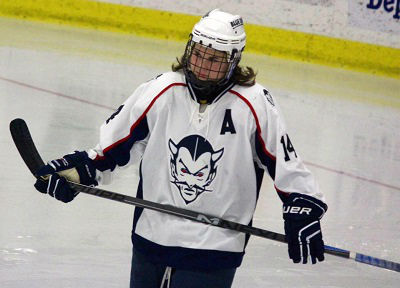 "I do enjoy the checking. The physical part of hockey is great," she said with a chuckle. "Girls hold the puck longer. Guys come at you (faster and harder) and you have to move the puck faster."
"I do enjoy the checking. The physical part of hockey is great," she said with a chuckle. "Girls hold the puck longer. Guys come at you (faster and harder) and you have to move the puck faster."
Getting knocked around in the corner in boys games is no problem. "I'm not intimidated by anyone on the ice," she said. "I've gotten stronger playing with the guys. I'm clearly not as strong, but I hold my own. It is all really just hockey to me at this point."
Her Sault coach, John Ferroni, said many opposing players and fans are not even aware there is a female on the ice. "She has definitely learned how to manage herself in the boys game," he said. "She is very competitive, sometimes even too competitive."
Indeed, she says, "I try to be the intimidating one on the ice."
That is not surprising since she has grown up with hockey a major part of her life. She began playing at age 4 and her father, Jim, is a former hockey coach at Lake Superior State University. Her uncle, Tom Bissett, is hockey coach at Grand Rapids Forest Hills Northern.
"If kids inherit things from their parents, she has inherited her dad's hockey IQ. She picked up the sport and has had a lot of hockey conversations with her father, and she comes from a hockey family," Ferroni said, noting her mother also has a strong athletic background.
Roque, who also has played golf and soccer and boasts 4.0 grade-point average taking advanced placement classes, said playing boys hockey was not a hard decision. She played in the strong Sault boys youth program from day one and realized the boys were the direction to take after playing girls hockey in the fall as an eighth grader.
"She always played with good hockey players, and they always accepted her as a girl," said Ferroni, in his fifth year as Sault coach. He said Roque "understands the game real well and made the commitment a long time ago. She is very dedicated to the sport."
Ferroni said Roque "has decent speed and decent quickness at the boys level. She is a strong skater and is very hard to knock off the puck. She is very elusive and always seems aware of what is going on around her."
That ability to see the game makes her "a playmaker without question" according to Ferroni. "She passes the puck extremely well; she has good, strong passing skills."
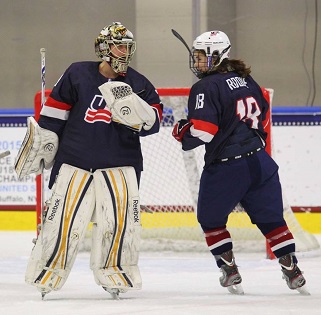 Ferroni admits he "had to look at a lot of things before taking her" on the team. After that process concluded, he said, "I knew she would be fine, but no way did I think she would rise to the level she has risen to. I didn't see that (second team all-state) coming."
Ferroni admits he "had to look at a lot of things before taking her" on the team. After that process concluded, he said, "I knew she would be fine, but no way did I think she would rise to the level she has risen to. I didn't see that (second team all-state) coming."
After checking out girls programs, Roque and Ferroni realized the Sault High School boys team would be the best path to follow. Ferroni said playing against other girls was not fast enough, and the puck movement among the boys was much better.
"We afforded her and gave her a great opportunity," Ferroni said. "She walked into a good, strong program as a freshman and was not just being a player, but was a real solid player. She definitely has raised the bar around here for girls.
"She has helped us as much as we have helped her."
Roque said Wisconsin "was the right fit for me. I loved everything about it, about Madison. Everything is about hockey. I just couldn't go anywhere else."
Roque also received scholarship offers from women's programs at North Dakota, Boston College and Boston University, among other schools.
This school year's participation figures will not be compiled until the spring, but about 250 girls total played on MHSAA boys teams in 2014-15.
 Denny Grall retired in 2012 after 39 years at the Escanaba Daily Press and four at the Green Bay Press-Gazette, plus 15 months for WLST radio in Escanaba; he served as the Daily Press sports editor from 1970-80 and again from 1984-2012. Grall was inducted into the Upper Peninsula Sports Hall of Fame in 2002 and serves as its executive secretary. E-mail him at [email protected] with story ideas for the Upper Peninsula.
Denny Grall retired in 2012 after 39 years at the Escanaba Daily Press and four at the Green Bay Press-Gazette, plus 15 months for WLST radio in Escanaba; he served as the Daily Press sports editor from 1970-80 and again from 1984-2012. Grall was inducted into the Upper Peninsula Sports Hall of Fame in 2002 and serves as its executive secretary. E-mail him at [email protected] with story ideas for the Upper Peninsula.
PHOTOS: (Top) Sault Ste. Marie's Abby Roque positions herself near the net during one of her team's games. (Middle) Roque is the first girl to play on the Sault's boys hockey team. (Below) Roque, here on her U.S. Under-18 team, brings international experience to the high school season. (Photos courtesy of the Sault Ste. Marie athletic department.)
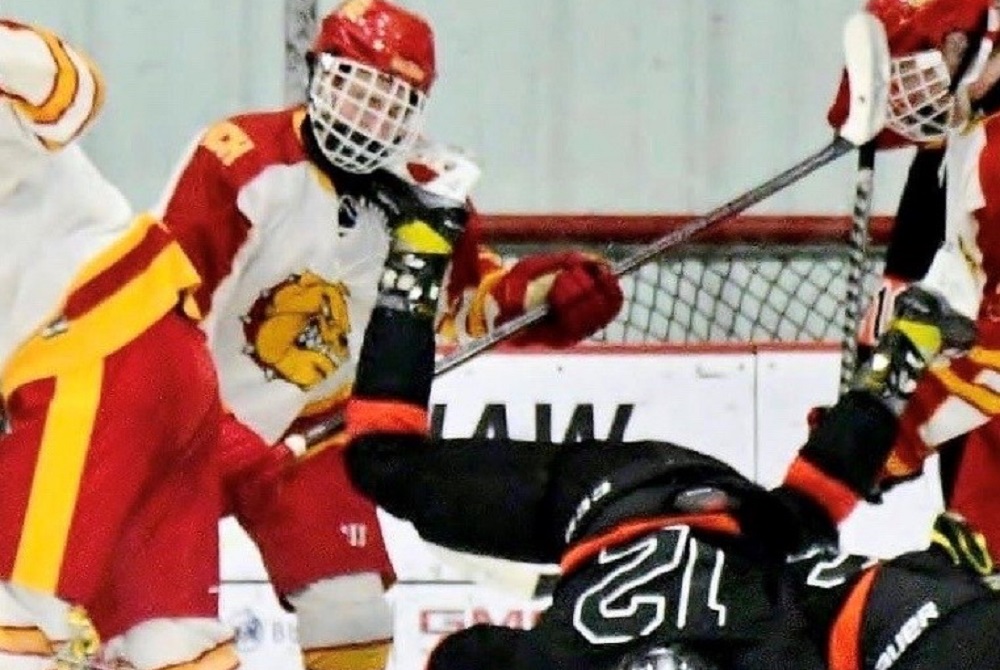
MHSAA Neck Guard Requirement Rooted in 1999 'Impossible to Forget' Injury
By
Ron Pesch
MHSAA historian
February 3, 2022
Dan DiCristofaro has made it a mission to remind schools, coaches, athletic directors, and other officials of the need to enforce an equipment rule, added to the MHSAA hockey rule book more than 20 years ago.
“Officials are not trying to give out misconduct penalties,” wrote DiCristofaro in a recent email, “but the avoidance by so many players to wear this piece of equipment as intended in its unaltered state or to even wear a neck guard at all has become almost the norm instead of the exception.”
“This is mandatory,” emphasized the long-time hockey official during a recent conversation. “It’s required, not recommended. Required.”
As a witness to an unforgettable occurrence during a game, DiCristofaro wants others to do what they can to reduce the odds of that moment happening again.
Rivals
The Wednesday, Feb. 10, 1999, game between Trenton and Redford Catholic Central was a rematch – the second game of a home-and-home series that had been played for years. Two of the state’s hockey powerhouses, the foes were certainly familiar with each other.
“The rivalry between Trenton and Catholic Central has probably gone on since the 60s,” recalled Trenton coach Mike Turner.
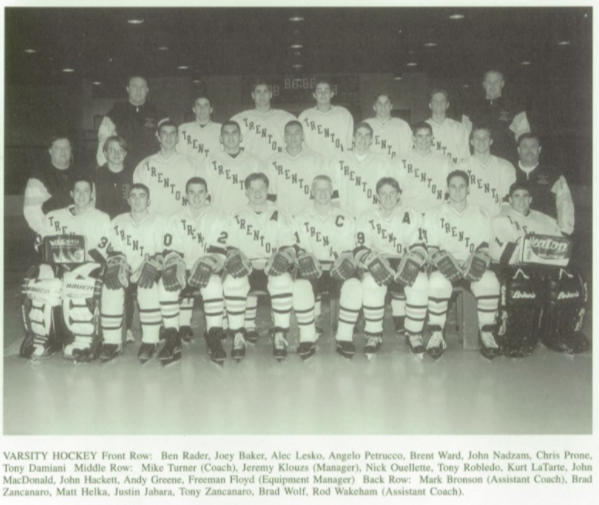 “They were usually two of the best teams in the state,” added Gordon St. John, Catholic’s coach at the time.
“They were usually two of the best teams in the state,” added Gordon St. John, Catholic’s coach at the time.
Both coaches were speaking in 2010, for REPLAY, a sports television series created by Gatorade, built around the re-staging of games between high school rivals. Fox Sports Net broadcast the game.
“If you go into our gymnasium, you will find 42 state banners,” noted Fr. Richard Ranalletti, principal at CC from 2000 to 2010. “Thirteen of them are in hockey” (1959, 1961, 1968, 1974, 1994, 1997, 1999, 2000, 2001, 2002, 2003, 2005, 2009). Founded in 1928, Detroit Catholic Central had moved to Redford Township 50 years later. (The campus moved again in 2005, this time to Novi.)
The city of Trenton was founded in 1834. A 1901 report in the Free Press speaks of architect Edward C. Leyen completing plans “for a high school building for the board of education of Trenton.”
“Since 1975, there’s 12 state championship banners (1976, 1979, 1980, 1982, 1986, 1991, 1996, 1998, 2003, 2004, 2008, 2009) hanging in our arena,” said Jerry Brown, Mayor of Trenton in his interview for the program.
Hank Minckiewicz, sports editor for the News-Herald in Trenton, summed it up: “Back in 1999, there was not a bigger rivalry in the state than Trenton and Catholic Central.”
Fifth-ranked Trenton had downed No. 1 CC, 1-0, at Redford Arena earlier in the 1999 season – the Shamrocks’ only loss at that point in the annual chase for a state title. The second game between the schools was played at Trenton’s Kennedy Recreation Center, then a single rink arena, before a full house. Catholic Central opened a 4-1 lead before the Trojans, dressed in their home white jerseys, stormed back to tie the game at 4-4 with about five minutes to play.
Nightmare Come to Life
The moment on the ice, caught on videotape, appears harmless enough.
“Late in the game, a Trenton player knocked a CC player off balance, sending his leg back into the air.” recounted Bill Roose in the Detroit Free Press, describing the freak accident that nearly took the life of Trojans senior Kurt LaTarte.
A 6-foot defenseman, LaTarte had been near the play and initially continued toward the puck, but then circled back and headed to the Trenton bench.
Lori Holcomb, a team trainer for Trenton, recalled the moment for REPLAY, documenting the night.
“Kurt was coming on to the bench, and he was kind of holding the side of his face and his neck and he said, ‘The kid’s boot hit me in the chin … I think my chin is cut.’
‘It was clean and straight,” she continued, “like surgical.”
It wouldn’t remain that way.
Guardian Angels
“The gash across the right side of his neck was four inches long and two inches wide,” wrote Roose in touching on the horror that quickly unfolded.
Chaos erupted on the Trenton bench as the color of LaTarte’s jersey changed from white to red.
“The game was so intense. … It was so jam-packed with people,” remembered DiCristofaro. “You couldn’t even hear yourself because it was so loud. We did not know that this had happened during the game until a linesman who happened to be standing next to the bench saw what was going on. … He’s the one who blew his whistle loud and kept blowing it for the play to actually stop.
“Once it all hit home and the play stopped … everybody went stone silent. Once everybody knew what was happening and everybody was informed, the players started kneeling, a lot of them were crying.”
The game was ended.
“Fortunately,” stated Roose, “(there were) a few guardian angels among the … spectators.”
Dr. David Wolf, nurse Leslie Zancanaro and firefighter Alec Lesko were all at the game because they had sons on Trenton’s team.
Wolf would accompany LaTarte to the hospital, “detailing his injuries to emergency room doctors” at Oakwood/Seaway Hospital in Trenton. Surgery that night repaired vein and muscle damage. On Friday, he was released from University of Michigan Hospitals in Ann Arbor. A week later, LaTarte was back in school.
In a follow-up article in the Free Press, the LaTarte Family thanked all involved with saving Kurt’s life.
DiCristofaro had officiated the game.
The Injury
Regrettably, this was far from the first time a hockey player had suffered such an injury. While certainly not common, and not always fatal, cuts like these are extremely serious. And for all involved – from spectator to player – impossible to forget.
Simply put, carotid arteries carry oxygenated blood to the head, face, and brain through the neck, while the jugular veins passing through the neck handle deoxygenated blood. Disruption to these vessels can quickly create major precarious problems instantly.
Few hockey fans can forget the horrific story of Clint Malarchuk, goalie for the Buffalo Sabres of the National Hockey League, nearly “bleeding to death on the ice when a skate severed his jugular vein,” in 1989. Many had forgotten that a similar injury to carotid arteries occurred to NHL player Jackie Leclair of the Montreal Canadians in 1954. (It would happen again in 2008, this time to Richard Zednick of the Florida Panthers). There have been various near misses and close calls in the NHL and professional hockey’s minor leagues.
Reports of cuts to the neck in Canada appeared in both U.S. and Canadian newspapers, including one causing the death of a 29-year-old father of two, Maurice Ayotte, who was playing amateur hockey in December 1973.
In another instance, a team trainer and a teammate were credited with saving the life of Kim Crouch of the Markham, Ontario Waxers in January 1975. An 18-year-old junior league goalie, he had been cut while making a save. The near tragedy inspired Kim’s father, Edward M. Crouch, to design a neck protector.
 “Maybe this neck guard will prevent other boys from going through what he did,” Edward told The Canadian Press. “It’s a combination of a baby’s bib and a turtleneck sweater.”
“Maybe this neck guard will prevent other boys from going through what he did,” Edward told The Canadian Press. “It’s a combination of a baby’s bib and a turtleneck sweater.”
By the fall of 1976, the initial “Kim Crouch Safety Collar” – weighing 3½ ounces and made of Nylon Ballistic Material and closed-cell foam – was available in stores. Two years later, it was being worn by several NHL and minor league goalies, and within five years, other manufacturers had throat protectors on the market.
Yet, their existence didn’t ensure broad acceptance or use.
It would take a series of tragic episodes that occurred within a span of two years to alter equipment requirements for youth hockey above the border.
In December 1983, a Montreal, Quebec boy, James Lechman, who played for the Class BB Rosemont team, died. Down on the ice in a scramble in front of his team’s net, the Rosemont goalie’s skate accidentally clipped the 15-year-old’s neck while he tried to block a shot.
In October 1984, Henry Reimer of the Richmond, British Columbia Sockeyes, a 17-year-old “standout centre” in the B.C. Junior Hockey League, survived a throat slit suffered when a teammate fell prior to a game during warmups, and his skate clipped Reimer. Fifty stitches – “30 internal and 20 external” – were required to close the wound. “Only the swift action of trainers and ambulance attendants prevented a tragedy,” stated the Vancouver, B.C. Province.
“If it was millimetres, either way,” Sockeyes’ coach Vic LeMire would later say, “he would be a statistic.”
A month later, Stephane Saint-Aubin, an 18-year-old Repentigny Olympiques player in the Junior AA Quebec league, died due to a similar injury. It was his first game with the team.
CCM and Cooper released new or redesigned versions of protectors that covered the neck and upper chest in 1985. Following his injury, Reimer, who would play college hockey on scholarship for the University of Illinois, worked with a Michigan company to develop another design.
But in September 1985, misfortune struck again within the same B.C. Junior Hockey League. Abbotsford British Columbia Falcons forward Jeff Butler, another 18-year-old, died after being cut on the throat by the “freshly sharpened, razor-sharp” blade of a teammate’s skate, according to another Province report.
The exhibition game, played before a crowd of just 200, was called off after the incident, midway through the second period. Doctors had labored to save Butler’s life but were unsuccessful.
“There are not words to describe what happened,” said coach Larry Romanchych to the Vancouver Sun.
Romanchych, who had previously played with Chicago and Atlanta in the NHL, immediately went to work searching for neck protectors. After examining the various types available, he purchased Crouch Collars.
“After what happened Saturday. I will never let my own (12-year-old) son on the ice without one,” vowed Romanchych. “And I will never let anybody who plays for me go without one. (The players) will get used to them, the same way we got used to playing with helmets. It’s just a shame that something … has to happen before we do anything about it.”
New Requirement
Some leagues in Canada took action and began to require players and goalies to wear neck guards. Players complained, stating the guards were uncomfortable and/or too hot to wear, and the rules were not always enforced. Heartbreaking accidents continued to occur.
The Canadian Standards Association (CSA)/Bureau de Normalisation du Quebec (BNQ) began work to establish guidelines for protection to be met by manufacturers. The injury to Malarchuk (an Alberta, Canada native) would ensure the passage of a national directive.
Still, it took time.
Challenges arose for manufacturers to distribute products to Canada’s more than 400,000 players, especially to small cities. That presented some implementation delays, but as of Jan. 1, 1994, it was a requirement to wear a Canadian Standards Association-approved throat protector (sometimes referred to as a neck laceration guard) labeled or stamped with the initials BNQ for all participants across the Canada Amateur Hockey Association.
Another death, this time in Sweden in 1995, moved the country to require all hockey players to wear neck guards.
Back in Michigan
“Neck guards are mandatory for youth hockey players in Canada,” wrote Anjali J. Sekhar days after LaTarte’s injury in an article for the Port Huron Times-Herald. “And while they are not mandatory in the United States, many people believe it’s common sense to wear them.”
While recognizing that the piece of equipment did not guarantee tragedy would always be avoided, the MHSAA still responded promptly to what had happened in Trenton. In May 1999, the MHSAA’s Representative Council, following Canada’s lead, instituted a mandatory neck guard rule for scholastic athletes in 2000.
Like our northern neighbors, the equipment worn by players must bear a label from BNQ. Today, the MHSAA is one of only two high school governing bodies in the United States to require hockey neck guards.
REPLAY by Gatorade
In May 2010, Gatorade reunited former members of the 1999 game from both DCC and Trenton, including LaTarte, their teams’ original coaching staffs, and two of the three officials from the game for a full-check, regulation-length replay of the contest. (Ironically, only weeks before, both schools had won MHSAA hockey titles.)
“For Trenton hockey alumni, redemption has come after years of waiting as they defeated their Detroit Catholic Central counterparts by a score of 4-2,” stated a news release following the contest.
 “From the moment Compuware Arena's doors opened, to the ceremonial puck-drop by game day commissioner, ‘Mr. Hockey®’ Gordie Howe, to the final horn sounding, excitement filled the arena. The teams, which hit the ice in front of nearly 4,000 people, were joined by Detroit hockey legends Scotty Bowman and Brendan Shanahan who provided their expertise and guidance as honorary coaches to the Catholic Central and Trenton squads, respectively.”
“From the moment Compuware Arena's doors opened, to the ceremonial puck-drop by game day commissioner, ‘Mr. Hockey®’ Gordie Howe, to the final horn sounding, excitement filled the arena. The teams, which hit the ice in front of nearly 4,000 people, were joined by Detroit hockey legends Scotty Bowman and Brendan Shanahan who provided their expertise and guidance as honorary coaches to the Catholic Central and Trenton squads, respectively.”
Prior to the game, training for former players had lasted eight weeks.
“We’re thinking this game was going to be more fun and ceremonial and casual,” said DiCristofaro, laughing at the memory. “The first few minutes shocked us with the physicality. This was serious hockey.
“These guys are running at each other. They were 17 and 18 years old again. There were some serious body checks. We had to start intervening immediately before somebody got hurt.
“They really went all-out with training and practice and off-ice conditioning to get ready for this game.”
“I knew this was an awesome opportunity to get the teams together and close this chapter,” said LaTarte. “Seeing how this came together, it was definitely worth every ounce of sweat.”
Prompting the Memory
Sadly, these memories of the happy ending were prompted by another much more recent nightmare. This January, once again, the razor-blade sharpness of an unintended air-bound ice skate took a life, this time in Connecticut. The player was Teddy Balkind, a 16-year-old sophomore at St. Luke’s School in New Canaan. The contest was with Brunswick School, located in Greenwich. In a letter written by Mark Davis, St. Luke’s head of school, to school families and reported in the media, he clarified details of the accident, misreported by some of the media:
“Teddy did not fall and was not lying on the ice. He was skating upright and low. During the normal course of play, another player’s leg momentarily went into the air and, through no fault of anyone’s, or any lack of control, his skate cut Teddy.”
Recommend, but not Require
“’Commercially manufactured throat guards designed specifically for ice hockey are required for all players, including goaltenders during regular season and tournament play,’ Connecticut Interscholastic Athletic Conference rules state,” noted the Toronto Star in coverage. “St. Luke’s and Brunswick play in the Fairchester Athletic Association, which like most prep school conferences follows the policy of USA Hockey and the NCAA, which recommend rather than require neck guards.”
“Founded on Oct. 29, 1937, in New York City … the organization was known as the Amateur Hockey Association of the United States (AHAUS) and changed to its present name in June 1991. While youth hockey is a main focus, USA Hockey also has vibrant junior and adult hockey programs that provide opportunities for players of all ability levels. The organization also supports a growing disabled hockey program.”
The Player Safety and Health Information page on USA Hockey’s website, while recommending neck laceration protectors and expressing concern about such injuries, stated (as of Feb. 3, 2022), “There is sparse data on neck laceration prevalence, severity and neck laceration protector (neck guard) effectiveness.”
“USA Hockey recommends that all players wear a neck laceration protector, choosing a design that covers as much of the neck area as possible. Further research & improved standards testing will better determine the effectiveness of neck laceration protectors.”
 Ron Pesch has taken an active role in researching the history of MHSAA events since 1985 and began writing for MHSAA Finals programs in 1986, adding additional features and "flashbacks" in 1992. He inherited the title of MHSAA historian from the late Dick Kishpaugh following the 1993-94 school year, and resides in Muskegon. Contact him at [email protected] with ideas for historical articles.
Ron Pesch has taken an active role in researching the history of MHSAA events since 1985 and began writing for MHSAA Finals programs in 1986, adding additional features and "flashbacks" in 1992. He inherited the title of MHSAA historian from the late Dick Kishpaugh following the 1993-94 school year, and resides in Muskegon. Contact him at [email protected] with ideas for historical articles.
PHOTOS (Top) The neck guard worn by this player may have prevented injury as another skater toppled in front of the goal. (2) The 1999 Trenton hockey team. (3) The Kim Crouch Safety Collar was the first neck guard of its kind. (4) The 1999 Detroit Catholic Central hockey team. (Top photo by Judy Gill; other photos collected by Ron Pesch.)

